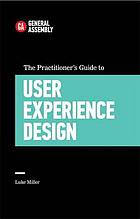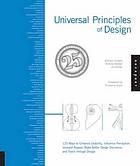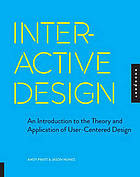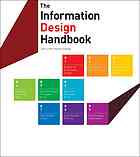Users and Cognition
How people understand systems

Read these to prepare for class discussion
-
Chapter 1, Seeing Through Users' Eyes,
pages 4-20
in Miller, L. (2015). The practitioner's guide to user experience design.
New York; Boston: Grand Central Publishing. -
Universal principles of design
Horror Vacui, 128 -
a relevant article from the Nielsen Norman Group
Minimize Cognitive Load to Maximize Usability -
Jason Withrow's
Cognitive Psychology & IA: From Theory to Practice
on the contribution cognitive psychology, especially visual perception, can make to interaction design (particularly interface design).

[top]
User Centered Design?

User-centered design (UCD) is a design philosophy that puts the user of a product, application, or experience at the center of the design process. In UCD, a designer strives for a detailed understanding of the needs, wants, and limitations of the peole who will use the end product and then make design choices that incorporate this understanding. [p. 12]
[top]
Cognitive Principles for ID

The goal of any information design task is to communicate a specific message to the end user in a way that is clear, accessible, and easy to understand ...
The study of human perception, thinking, and learning can provide the designer with crucial insight into the needs of the end user. Even an elementary understanding of cognitive science and educational theory can make a big difference in the way aesthetic decisions are made. [p. 54-55]
[top]
Additional resources
History of Graphic Design
A paper by Patrick J. Lynch, entitled, Visual design for the user interface provides a history of graphical design and some psychological theories that have shaped it. Published originally in 1994, Journal of Biocommunications, 21(1):22-30
Memory
George Miller, The Magical Number Seven, Plus or Minus Two: Some Limits on Our Capacity for Processing Information. Originally published in The Psychological Review, 1956, vol. 63, pp. 81-97.
Cognitive Theories and HCI
An extensive critique of the role of cognitive theory in HCI is
Rogers, Y. (2004)
New Theoretical approaches for Human-Computer Interaction.
Annual Review of Information, Science and Technology, 38, 87-143.
[PDF]
GOMS (Goals, Operators, Methods, and Selection rules)
To find out more about GOMS and the MHP visit the Usability First page.
Also look at David Kieras and Bonnie John.
Mental Models
A good introduction by Ruth Byrne (a cognitive psychologist).
an on-going discussion about mental models
An article by Scott McDaniel What's your idea of a mental model? with a follow on by Indi Young What Is Your Mental Model?
A podcast of a talk by Stephen Payne given in 2006 on mental models
Distributed Cognition
Look at A Brief introduction to distributed cognition by Yvonne Rogers (2005).
Cognitive Disabilities
For more on cognitive disabilities, Heather Mariger writes about the problems and challenges facing millions of web users who suffer from various cognitive impairments, such as Alzheimers, and provides a set of design recommendations for web design.
A bit more insight into the world of cognitive disabilities can be obtained by looking at the Reports from a Resident Alien blog.
[top]

